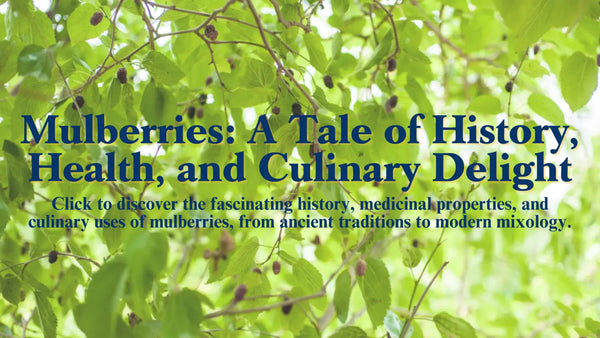The History of Milk Punch: A Culinary-Alchemical Exploration
Milk Punch occupies a unique position at the intersection of culinary art and alchemical experimentation—a concoction whose successful creation seems paradoxical. Its origins are shrouded in myth and anecdote, involving figures as diverse as women in their kitchens, rogues in their studies, and possibly even a royal spy. Aphra Behn, the 17th-century English author, playwright, and reputed royal operative, is often attributed as the spiritual progenitor of Milk Punch, while another British woman, Mary Rockett, is recognised for recording the first formal recipe in 1711.
Rather than debating the historical lineage, it is more productive to examine the result: Milk Punch is an elegant paradox, drawing complexity from its simplest ingredient—milk. The drink works precisely because the milk curdles, initiating a process akin to alchemy, where solids and liquids transform into a refined and clarified final product.
The clarifying process, during which milk solids are strained out, imparts the defining characteristics of Milk Punch. The milk interacts with tannins and acids, binding them and ultimately leaving behind a crystal-clear liquid with an opulent mouthfeel. The outcome is a beverage that balances the fiery warmth of spirits, the sharp acidity of citrus, and the smooth richness of milk. The result is ambrosial, ethereal—a drink that straddles luxury and subtlety while packing a delightful punch.
Benjamin Franklin, that polymath of peculiar passions, was so enamoured by Milk Punch that he documented his own recipe in 1763, employing brandy and lemon with hot milk. By the 18th century, Milk Punch had garnered significant popularity across Britain and its colonies, celebrated particularly for its stability—once clarified, it could be stored almost indefinitely without spoilage. Even Queen Victoria, with her famously unimpressed countenance, was said to favour the drink, issuing a royal warrant in 1838 to Nathaniel Whisson, suppliers of Milk Punch to Her Majesty.
The underlying science of Milk Punch is captivating. When milk is introduced to an acidic component—typically citrus juice—the acid induces the curdling of milk proteins, primarily casein. These curds subsequently trap impurities, tannins, and other undesirable elements, resulting in a clarified liquid of remarkable stability and smoothness. This process also softens the harsher aspects of the spirits, yielding a cocktail of refined balance. Dave Wondrich, a cocktail historian of some repute, notes that this curdling and clarifying technique was initially employed as a preservation strategy, enabling Milk Punch to be bottled and stored for extended periods without degradation. The interplay of acids, alcohol, and milk proteins creates a texture and flavour profile that has continued to intrigue bartenders for generations.
As highlighted by Difford's Guide, Milk Punch exemplifies an unexpected transformation—curdling milk to achieve an alchemical wonder that yields a clear, silky, and richly flavoured beverage. This speaks to the ingenuity of early mixologists, who discovered that by embracing curdling, they could produce a drink that was visually stunning and exhibited layers of complexity.
It is, of course, a drink that epitomises contradiction—milk that is no longer milk, a punch that caresses instead of pummeling. It is a drink to be sipped in the fading glow of a long afternoon, where every element seems both familiar and gloriously transformed. The historian in one’s soul appreciates its preservation, the hedonist appreciates the heady warmth, and the romantic—well, the romantic just drinks.
It is Hemingway in a glass: straightforward, bold, yet with unexpected depth. There is a simplicity in its clarity, a starkness in its delivery. Milk Punch doesn’t pretend to be anything other than what it is—direct and unapologetic. It delivers its pleasures without flourish, like a well-written sentence, cutting to the heart of what it means to savour something that is, at its core, elemental.
Insights from Psychrophilic Bacteria Studies
Interestingly, research into psychrophilic bacteria and their effects on milk has provided insights into the stability and flavour profile of Milk Punch. Psychrophilic bacteria are known to thrive at low temperatures and can cause flavour and physical changes in milk, which has implications for preserving the quality of milk-based drinks. Studies have shown that bacterial activity can lead to flavour defects such as an unclean or astringent taste, even when the population levels are relatively low (5 to 20 million per millilitre).
In Milk Punch, the process of curdling and subsequent filtration removes many of these impurities and bacteria, resulting in a clarified product with enhanced stability. The removal of milk solids and impurities effectively mitigates the risk of spoilage, which is why Milk Punch can be stored for extended periods without compromising its flavour. This process echoes findings in dairy science, where proper management of bacterial growth and careful handling of milk can significantly impact the final product's quality and shelf life.
A Cocktail of Celebration: Moonacres Kitchen and Matthew Evans' 'Milk'
Recently, we had the honour of crafting a welcome drink for the book launch of Milk by Matthew Evans, hosted at the charming Moonacres Kitchen. Milk is an exploration of the essence of this fundamental liquid, tracing its cultural, biological, and political impact. It celebrates the majesty of this noble liquid, from its role in sustaining life to its transformation into cheese, butter, and yoghurt. The event celebrated Evans' deep dive into milk’s rich history and its many modern iterations, and what better way to honour the theme than with a Milk Punch of our own?
Using non-pasteurised, grass-fed milk from Schofield's Dairy in Avoca, the Milk Punch served at the event reflected the natural and unprocessed qualities discussed in Evans' book. This particular Milk Punch was an homage to tradition, showcasing the craft of transforming fresh milk into an exquisite cocktail—a perfect way to toast the launch of a book dedicated to understanding the transformative nature of milk.
A How-To Guide: Crafting a Clarified Milk Punch
So, you’ve got a taste for history, and now you’d like a taste of Milk Punch. Fortunately, making a clarified version at home is far from impossible. It requires patience, a steady hand, and an understanding of the chemical ballet that unfolds when milk meets acid.
Ingredients:
- 400 ml mulberry-infused bourbon
- 150 ml Illawarra plum & lavender syrup
- 150 ml lemon juice
- 150 ml pineapple juice
- 200 ml lemon myrtle tisane
- 400 ml whole milk (full-fat works best for clarity and flavour)
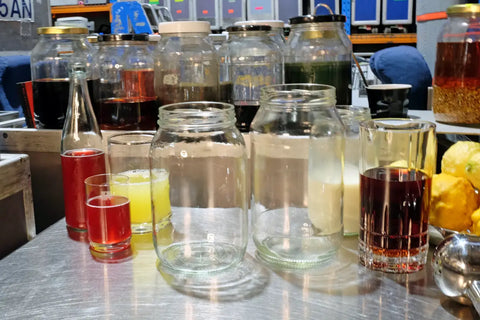
Method:
- Combine Your Base: In a mixing bowl, blend the mulberry-infused bourbon, Illawarra plum & lavender syrup, lemon juice, pineapple juice, and lemon myrtle tisane. Stir until all ingredients are well combined. The citrus and pineapple juices will provide the acid necessary for clarifying the milk.
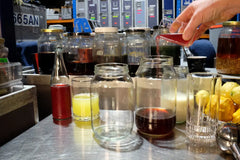
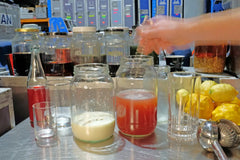
- Add the Milk: Gently heat the milk until it reaches about body temperature, then slowly pour the punch mixture into the warm milk—never the other way around! This sequence is critical to ensure proper curdling, which binds unwanted tannins and particles. The curdling process is essential for achieving the final clarified result.
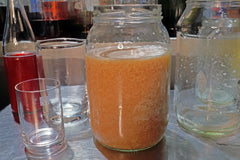
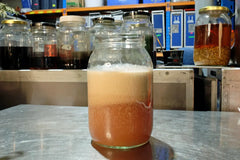
- Let It Rest: Allow the mixture to sit undisturbed for at least 30 minutes. You’ll notice the milk curdling almost immediately, but it needs time to fully separate and do its magic—trapping impurities and leaving behind a clarified liquid.
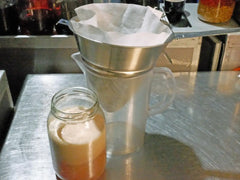
-
Strain the Mixture: Line a fine-mesh sieve with cheesecloth (or even a coffee filter, if you’re patient) and strain the mixture. This may take some time, so be patient. You might need to re-filter if the liquid is not clear on the first pass. The goal is to achieve a beautiful, clear liquid without any cloudiness.
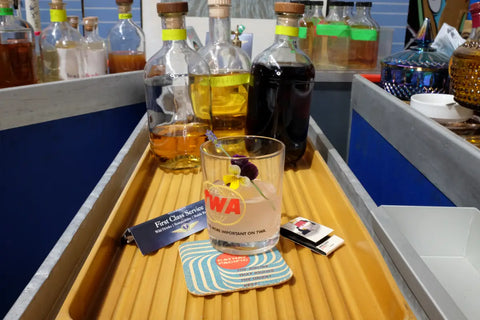
- Bottle and Enjoy: Once filtered, the liquid will be a gorgeous, translucent ruby colour from the mulberries and Illawarra plums. Transfer it to a clean bottle and refrigerate. It will keep for weeks, if not months, thanks to the absence of any unstable milk solids.
Serve your clarified Mulberry Milk Punch over a large ice cube, garnished with a sprig of lavender or a twist of lemon peel for added aromatic appeal. This modern take on a historical classic captures the delicate balance of rich flavours, tart acidity, and smooth opulence.
References
-
Rockett, Mary. The First Milk Punch Recipe, 1711.
-
Wondrich, Dave. Punch: The Delights (and Dangers) of the Flowing Bowl. Perigee Trade, 2010.
-
Franklin, Benjamin. Benjamin Franklin's Milk Punch Recipe, 1763.
-
Difford, Simon. Difford's Guide to Cocktails and Spirits. Difford's Guide, www.diffordsguide.com.
-
Punch, J. D., Olson, J. C., Jr., & Thomas, E. L. Psychrophilic Bacteria: Population Levels Associated with Flavor or Physical Change in Milk. Journal of Dairy Science, 1965.
-
Gyllenberg, H., Eklund, E., Antila, M., & Bartiovaara, U. Contamination and Deterioration of Market Milk. Acta Agr. Scand., 1959-1960.
-
American Public Health Association. Standard Methods for the Examination of Dairy Products. 11th ed., 1961.
-
Hull, M. E. Studies on Milk Proteins: Colorimetric Determinations of the Partial Hydrolysis of the Protein in Milk. Journal of Dairy Science, 1947.
-
Parker, R. B., & Elliker, P. R. Effect of Spoilage Bacteria on Biacetyl Content and Flavor of Cottage Cheese. Journal of Dairy Science, 1953.
-
Thomas, E. L., Nielsen, A. J., & Olson, J. C., Jr. Hydrolytic Rancidity in Milk: A Simplified Method for Estimating the Extent of Its Development. American Milk Review, 1955.




